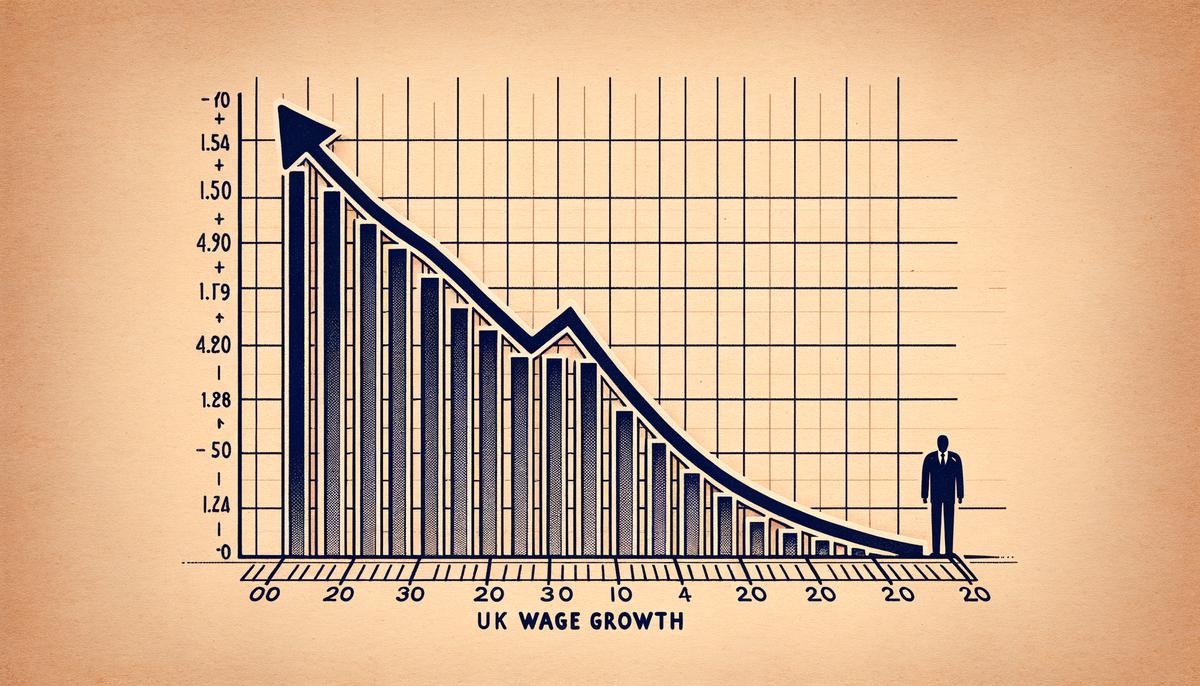
UK Wage Growth Slowdown
In the landscape of the UK’s economy, wage growth is an important indicator, reflecting the relationship between employment trends and inflationary pressures. This article aims to explore recent developments in wage dynamics, examining how they interact with broader economic factors and what they mean for future prospects.
Current Wage Growth Rate
In the UK, wage growth has seen a notable shift, unveiling patterns that reflect broader economic currents. As of late 2023 and early 2024, pay growth, particularly excluding bonuses, slowed down to 6.2% in the three-month period ending in December 2023 compared to the same timeframe a year prior, as reported by the Office for National Statistics (ONS).1 This deceleration from earlier peaks suggests a cooling jobs market, though wages continue to outpace inflation. Inflation, sitting at 4%, has been a constant factor, with real wages adjusting for inflation marking a 1.9% increase.
Despite the observed slowdown, the labour market’s response varies, with certain sectors like healthcare and leisure showing job gains, albeit at a slower pace. The underlying factors include demographic shifts and sector-specific demands. Additionally, concerns exist regarding the reliability of job market data after the Office for Statistics Regulation halted its Labour Force Survey due to declining response rates.2 However, the overall employment rate has improved, reaching 75%, indicating a labour market that, while cooling, shows signs of growth and ongoing challenges.

Impact of Inflation on Wages
Inflation plays a significant role in shaping wage growth; it influences both employer generosity and employee necessity. As inflation rises, the cost of living increases, putting pressure on household budgets and leading workers to seek higher pay to maintain their standard of living. This desire for increased wages is more pronounced when inflation outpaces earnings growth, a situation many have experienced in recent times. However, when wage growth begins to exceed inflation, temporary relief is felt.
The central bank, particularly the Bank of England in the UK context, monitors this relationship closely, adjusting interest rates to manage inflation’s fluctuations. Lowering interest rates can stimulate spending and investment but also risks increasing inflation further, making the central bank’s task challenging. Conversely, when interest rates rise to control inflation, it can slow wage growth, tighten job markets, and potentially signal economic concerns.

Labour Market Trends
The UK labour market is experiencing a significant transformation shaped by various trends, including:
- Persistent skills shortage
- Resulting wage pressures
- Shift in job preferences
- Rise in economic inactivity among certain demographic groups
Businesses face the challenge of not only filling current vacancies but also retaining talent, as workers benefit from the competitive landscape to secure better pay and positions. This situation is exacerbated by the shift in job preferences and the rise in economic inactivity among certain demographic groups, highlighting a deeper structural change within the job market.
As wage growth continues to be a focal point for economic analysis, its effects extend beyond the immediate labour market into broader economic policy. The Bank of England’s cautious approach towards interest rate adjustments reflects the delicate balance required to sustain growth while managing inflationary pressures.3 This scenario underscores the interconnectedness of wage trends with macroeconomic stability, pointing towards an evolving landscape that demands flexible responses from both businesses and regulatory bodies.

Future Outlook of Wage Growth
Looking ahead, the UK’s wage growth outlook remains a topic of interest amidst the backdrop of evolving economic conditions. Projections suggest a complex interplay between market forces and policy decisions. The concern regarding wage escalation persists, especially as earnings growth continues to be monitored by policymakers. This scrutiny largely stems from the dual objectives of fostering economic stability while ensuring that wage increases do not unintentionally trigger inflationary pressures.
The landscape of the UK jobs market suggests a gradual adaptation, potentially altering the future trajectory of wage growth. Factors such as technological advancements, shifting workforce expectations, and the persistent challenge of skills shortages are poised to reshape the dynamics of wage setting. These elements, combined with the overarching aims of sustaining economic growth and enhancing job security, suggest a measured yet dynamic approach to wage adjustments moving forward.

As we examine the multifaceted realm of wage growth within the UK, it becomes clear that this aspect of economics is interconnected with various factors. The relationships between wages, inflation, employment rates, and policy decisions create a delicate balance that requires careful management. Understanding these dynamics will be crucial for maintaining economic stability and fostering an environment where both businesses can thrive and employees can experience real income growth.
- Office for National Statistics. Average weekly earnings in Great Britain: March 2024. London: Office for National Statistics; 2024.
- Office for Statistics Regulation. OSR statement on the National Statistics status of the Labour Force Survey. Newport: Office for Statistics Regulation; 2023.
- Bank of England. Monetary Policy Report – February 2024. London: Bank of England; 2024.

Share
Facebook
X
LinkedIn
Telegram
Tumblr
WhatsApp
VK
Mail